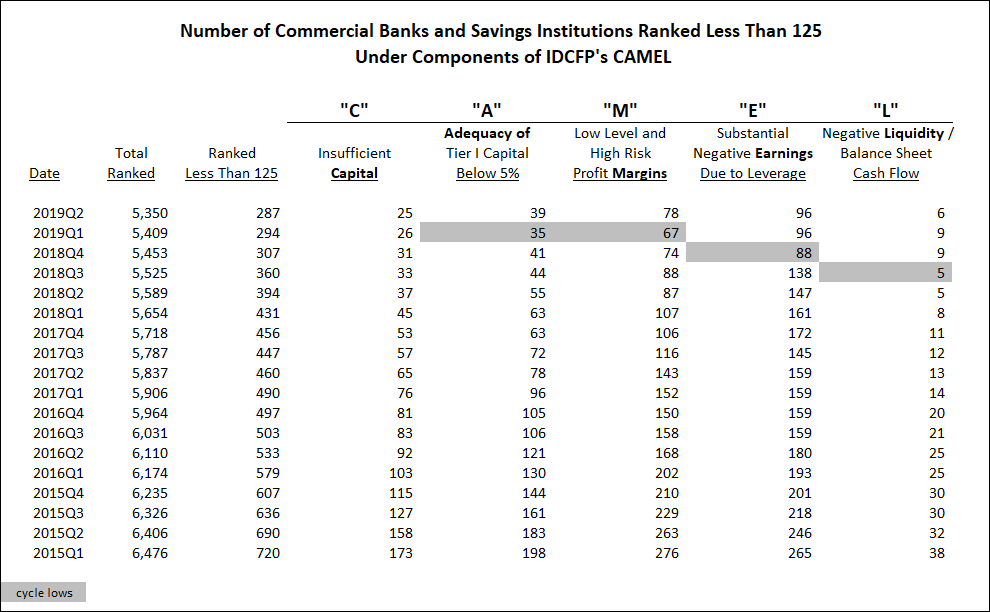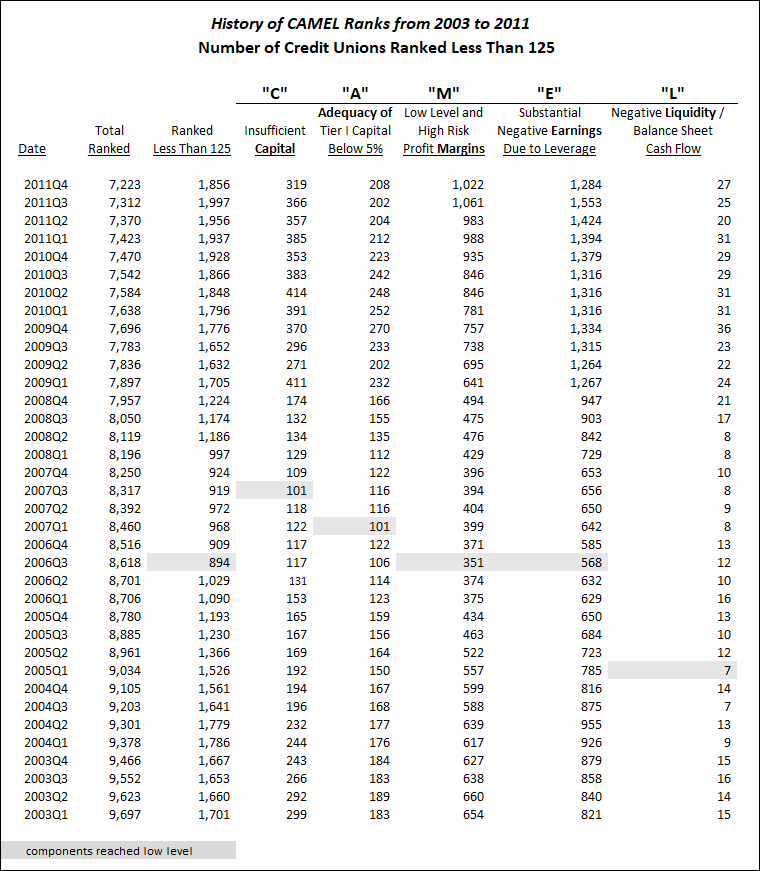Negative Balance Sheet Cash Flow Leads to Liquidity Risk
IDC Financial Publishing (IDCFP) utilizes the acronym CAMEL to represent the financial ratios used to evaluate the safety and soundness of commercial banks, savings institutions and credit unions. This article explains how we use liquidity as a component of our CAMEL rating, and why it is valuable and important to monitor.
Liquidity risk occurs when an institution’s loan delinquency exceeds 4% of its total loans and its balance sheet cash flow is substantially negative.
Balance sheet cash flow is operating cash flow minus financial cash flow.
- Operating cash flow equals the annual change in retained earnings less the annual change in growth-producing fixed assets. The purpose of measuring operating cash flow is to determine an institution’s ability to finance the growth of fixed assets.
- Financial cash flow equals the annual change in liabilities and capital (excluding retained earnings) less the annual change in earning assets, such as loans, investments, and cash-equivalents.
Large negative balance sheet cash flows occur if annual change in retained earnings is negative and/or the annual change in all other liabilities substantially exceeds the annual change in earning assets. An institution with poor loan quality or risky investments will experience asset write-offs or write-downs. At the same time, an at-risk institution will finance its asset base by relying on deposit increases and new borrowing. The resulting negative balance sheet cash flow threatens the safety and soundness of the financial institution.
Our CAMEL safety ratings of banks, savings institutions, and credit unions range from 300 (the top grade attainable) to 1 (the lowest). From the early 1990’s through today, institutions using our ranks determined that ratings lower than 125 were deemed below investment grade. Institutions with significant negative balance sheet cash flow as a percent of equity capital, and loan delinquency in excess of 4% of all loans are ranked by IDCFP below 125.
Forecasting the Next Banking Crisis - Updated with 2019Q2 ranks
Out of the 5,350 total commercial banks and savings institutions, we have identified 287 ranked less than 125 in the second quarter of 2019. When we see the number of these poorly rated banks reach a low and begin to rise, both in the total institutions ranked and by CAMEL component, this indicates the potential for a future banking problem
Table I

Table I illustrates the trend of CAMEL components when examining commercial banks and savings institutions ranked less than 125 by IDCFP. Most of these components have reached lows and are rising as of the second quarter of 2019. However, the number of total institutions ranked less than 125 continues to decline.
- Most important, the number of risky institutions reached a new low of 287 in the second quarter of 2019.
- The “C” component, or institutions with insufficient capital, also fell to a new low of 25 in the second quarter of 2019.
- The “A” component represents institutions lacking adequacy of capital to cover delinquency with less than 5% risk-adjusted capital. These institutions rose from 35 to 39 in the second quarter of 2019.
- The “M” component, which uses margins as a measure of management, rose from 67 to 78 banks in the second quarter of 2019.
- The “E” component represents institutions exhibiting negative earnings returns on financial leverage (ROFL). These banks hit a low of 88 in the fourth quarter of 2018 and remained at 96 in the second quarter of 2019.
- Finally, the “L” component represents negative liquidity. The number of banks ranked below 125 with negative balance sheet cash flow and high loan delinquency dropped to 6 in the second quarter of 2019 but remained above the low of 5 in the third quarter of 2018.
To forecast a banking crisis, the number of all banks ranked less than 125, as well as those in each component of CAMEL, must reach a low and begin to increase. With 4 of 5 CAMEL components currently showing this trend, there is some indication of risk.
Early Warning Indicators in History
In history, we have seen banks in total and the components of CAMEL hit lows and begin to rise, which forecast the banking crisis of 2008. The number of commercial banks and savings institutions ranked below 125 reached a low in the second quarter of 2006, two years before the crisis. More importantly, leading up to that point, the number of banks in 4 out of the 5 components of CAMEL also reached lows from the third quarter of 2005 through the first quarter of 2006, and then began to rise.
As seen in Table II below,
- The number of high-risk institutions reached a new low of 885 in the second quarter of 2006 and steadily rose in subsequent quarters.
- Commercial banks and savings institutions with insufficient capital reached a low number of 47 institutions in the third quarter of 2006 and began to increase in subsequent quarters.
- The number of financial institutions with less than 5% adequacy of capital reached a low count of 29 in the third quarter of 2005, and then increased.
- The number of banks and savings institutions with a lack of profitability, or low and unstable margins, reached a low of 178 in the fourth quarter of 2005, and subsequently rose.
- The number of banks and savings institutions with severe negative earnings due to financial leverage reached a low number of 185 in the fourth quarter of 2005, and then increased.
- Finally, the number of institutions with high loan delinquency and negative balance sheet cash flow, or negative liquidity, reached a low of 2 in the first quarter of 2006, and then increased.
In addition to the total number of banks ranked less than 125, all 5 categories of rank provided a timely indication of risk and potential failure. All these elements combined displayed a trend where the number of institutions reached a low and subsequently increased and forecast the banking crisis of 2008.
Table II

As seen in history, the increase in the number of financial institutions with an IDCFP CAMEL rating below 125, or below investment grade, forecast the bank financial crisis a few years later. Our ranks are critical for investors to monitor financial institutions and prepare for potential risk.
To view our products and services please visit our website at www.idcfp.com . For further information about our CAMEL ranks, or for a copy of this article, please contact us at 800-525-5457 or info@idcfp.com.
John E Rickmeier, CFA, President, jer@idcfp.com
Robin Rickmeier, Marketing Director
